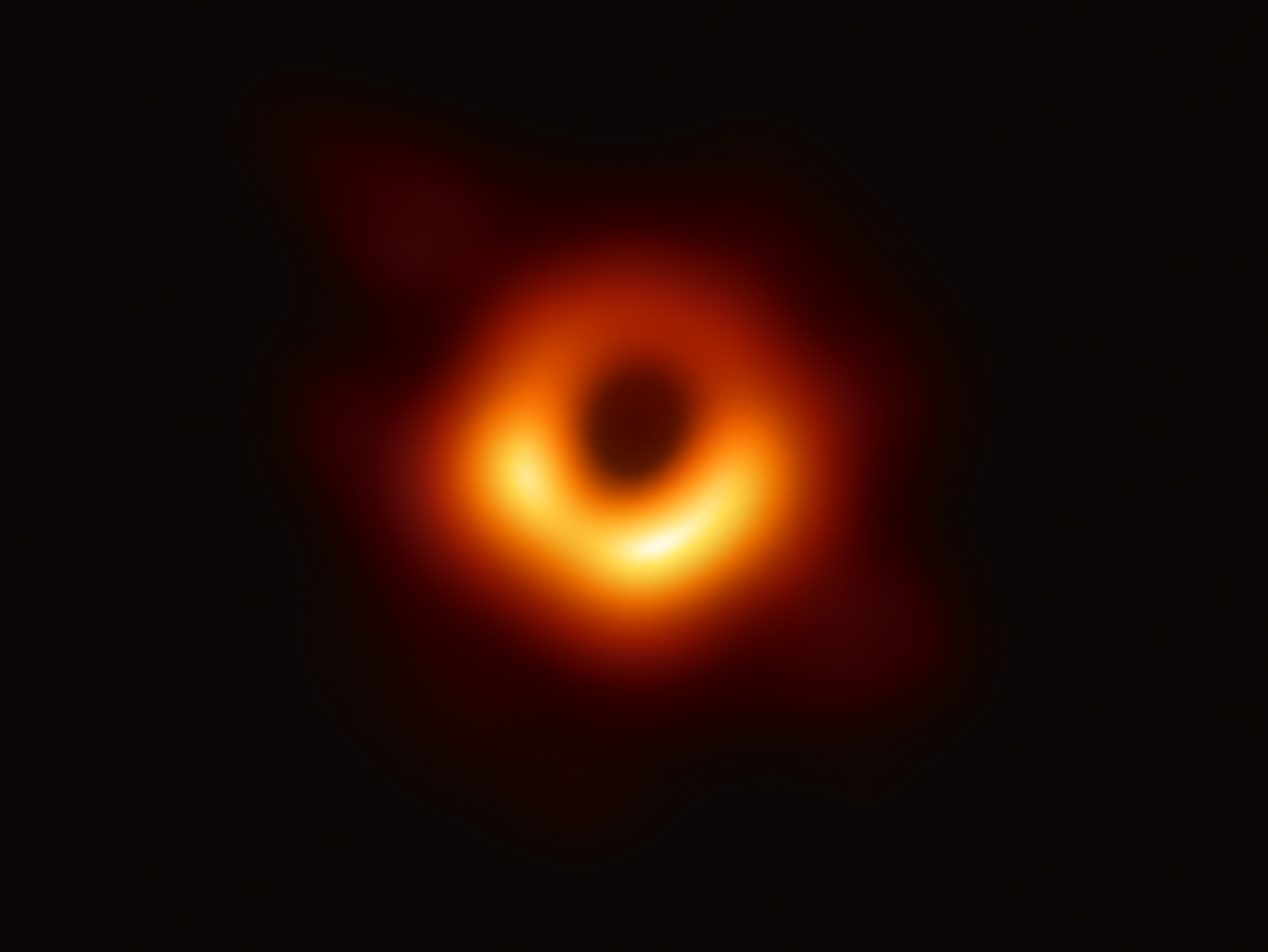The Italian 14th-century painter, Giotto di Bondone, when asked by the Pope to prove his talent, is said to have swung his arm and drawn a perfect circle. But geometric perfection is limited by the medium. Inspect a canvas closely enough, and every circle will eventually appear grainy. If perfection is what you seek, don’t look at man-made art, look at the sky. More precisely, look at a black hole.
Looking at a black hole is what the Event Horizon Telescope has done for the past 12 years. Yesterday, the collaboration released the long-awaited results from its first full run in April 2017. Contrary to expectation, their inaugural image is not, as many expected, Sagittarius A*, the black hole at the center of the Milky Way. Instead, it is the supermassive black hole in the elliptic galaxy Messier 87, about 55 million light-years from here. This black hole weighs in at 6.5 billion times the mass of our sun, and is considerably larger than the black hole in our own galaxy. So, even though the Messier-87 black hole is a thousand times farther away than Sagittarius A*, it still appears half the size in the sky.
The Event Horizon Telescope (EHT) is not less remarkable than the objects it observes. With a collaboration of 200 people, the EHT uses not a single telescope, but a global network of nine telescopes. Its sites, from Greenland to the South Pole and from Hawaii to the French Alps, act in concert as one. Together, the collaboration commands a telescope the size of planet Earth, staring at a tiny patch in the northern sky that contains the Messier-87 black hole.
Black holes bend light so much that it can wrap around the horizon multiple times. The resulting image is too complicated to capture in simple equations.
In theory, black holes are regions of space where the gravitational pull is so large that everything, including light, becomes trapped for eternity. The surface of the trapping region is called the “event horizon.” It has no substance; it is a property of space itself. In the simplest case, the event horizon is a sphere—a perfect sphere, made of nothing.
In reality, it’s complicated. Astrophysicists have had evidence for the existence of black holes since the 1990s, but so far all observations have been indirect—inferred from the motion of visible stars and gas, leaving doubt as to whether the dark object really possesses the defining event horizon. It turned out difficult to actually see a black hole. Trouble is, they’re black. They trap light. And while Stephen Hawking proved that black holes must emit radiation due to quantum effects, this quantum glow is far too feeble to observe.
But much like the prisoners in Plato’s cave, we can see black holes by observing the shadows they cast. Black holes attract gas from their environment. This gas collects in a spinning disk, and heats up as it spirals into the event horizon, pushing around electric charges. This gives rise to strong magnetic fields that can create a “jet,” a narrow, directed stream of particles leaving the black hole at almost the speed of light. But whatever strays too close to the event horizon falls in and vanishes without a trace.
At the same time black holes bend rays of light, bend them so strongly, indeed, that looking at the front of a black hole, we can see part of the disk behind it. The light that just about manages to escape reveals what happens nearby the horizon. It is an asymmetric image that the astrophysicists expect, brighter on the side of the black hole where the material surrounding it moves toward us, and darker where it moves away from us. The hot gas combined with the gravitational lensing creates the unique observable signature that the EHT looks out for.
The experimental challenge is formidable. The network’s telescopes must synchronize their data-taking using atomic clocks. Weather conditions must be favorable at all locations simultaneously. Once recorded, the amount of data is so staggeringly large, it must be shipped on hard disk to a central location for processing.
The theoretical challenges are not any lesser. Black holes bend light so much that it can wrap around the horizon multiple times. The resulting image is too complicated to capture in simple equations. Though the math had been known since the 1920s, it wasn’t until 1978 that physicists got a first glimpse of what a black hole would actually look like. In that year, the French astrophysicist Jean-Pierre Luminet programmed the calculation on an IBM 7040 using punchcards. He drew the image by hand.
Today, astrophysicists use computers many times more powerful to predict the accretion of gas onto the black hole and how the light bends before reaching us. Still, the partly turbulent motion of the gas, the electric and magnetic fields created by it, and the intricacies of the particle’s interactions are not fully understood.
The EHT’s observations agree with expectation. But this result is more than just another triumph of Einstein’s theory of general relativity. It is also a triumph of the astronomers’ resourcefulness. They joined hands and brains to achieve what they could not have done separately. And while their measurement settles a long-standing question—yes, black holes really do have event horizons!—it is also the start of further exploration. Physicists hope that the observations will help them understand better the extreme conditions in the accretion disk, the role of magnetic fields in jet formation, and the way supermassive black holes affect galaxy formation.
When the Pope received Giotto’s circle, it was not the image itself that impressed him. It was the courtier’s report that the artist produced it without the aid of a compass. This first image of a black hole, too, is remarkable not so much for its appearance, but for its origin. A black sphere, spanning 40 billion kilometers, drawn on a background of hot gas by the greatest artist of all: Nature herself.
Sabine Hossenfelder is a research fellow at the Frankfurt Institute for Advanced Studies where she works on physics beyond the standard model, phenomenological quantum gravity, and modifications of general relativity. If you want to know more about what is going wrong with the foundations of physics, read her book Lost in Math: How Beauty Leads Physics Astray.
WATCH: Why black holes fascinate the public.































